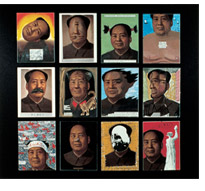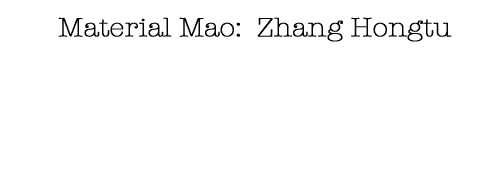







Zhang Hongtu is best known for his satirical portrayal of Mao, and is one of the leading Chinese artists living in the United States. Born to a traditional Muslim family in 1943, Zhang Hongtu has grappled with his personal identity as a minority living in China. During the Cultural Revolution, his father was branded a rightist and Hongtu was excluded from participating in the Red Guards. Hongtu became disillusioned with the Chinese government, as he witnessed beatings and poverty throughout China. His paintings seek to examine and question the past “by focusing on tradition in search of an escape from its constraints, Zhang Hongtu’s project infuses the art of past with his own vitality and gives it an on-going presence” (Silbergeld). Zhang Hongtu’s experimental art reinterpreted Chinese and Western icons.
Zhang Hongtu had no idea of its significance in 1987 when he took brush and paint to a Quaker Oats box… The idea that the Chairman was ubiquitous, so hard to get away from even here in America, and that just a few quick strokes of the brush could turn an American icon into a Chinese one, proved to be a turning point in Zhang's career. With these few strokes he became perhaps the first exemplar of the "political pop" movement that helped to launch contemporary Chinese painting into its current international trajectory (Silbergeld).
Hongtu’s work tests the boundaries between reality and fiction. In his Material Mao series he utilizes repetition and cut-out silhouettes of Mao. Chairmen Mao (1989) was painted immediately after the Tiananmen massacre, commenting on the ubiquitous and hypocrisy of Mao’s image.
These images always dealt with an icon – related to history, religion, or culture. In those works, I used simple materials – only burlap and cardboard-but shifted between multiple images cut out from the surface. Mao’s portrait was only one of these multiple images. In 1991, I switched strategies and started to focus on a single image of Mao which I cut from the surface of many different materials. I was moving between positive and negative space, between presence and absence, and between the iconic image and everyday materials (Zhang Hongtu).
Hongtu also used organic materials in his work, such as rice, corn, and plywood. Inspired by minimalist and pop artists, like Andy Warhol and Duchamp. By employing different strategies throughout his work, the images of Mao take on multiple meanings and dimensions.
There is a contrast between the natural everyday materials and the image, which is god-like, worshipped by a billion people. The viewer has to move between empty image and the material, so that the material works together with the image and becomes part of the content, not only the medium… The materials always reminded me of people’s lives in China, especially the years from 1959 to 1962 after the Great Leap Forward, when thousands and thousands of people died of starvation. While I was working on these two pieces I was very careful, because when I wasted some of the corn kernels or grains of rice I felt guilty. The materials used by the Minimalists came from their life experience and the materials I use come from my life experience in China (Zhang Hongtu).



